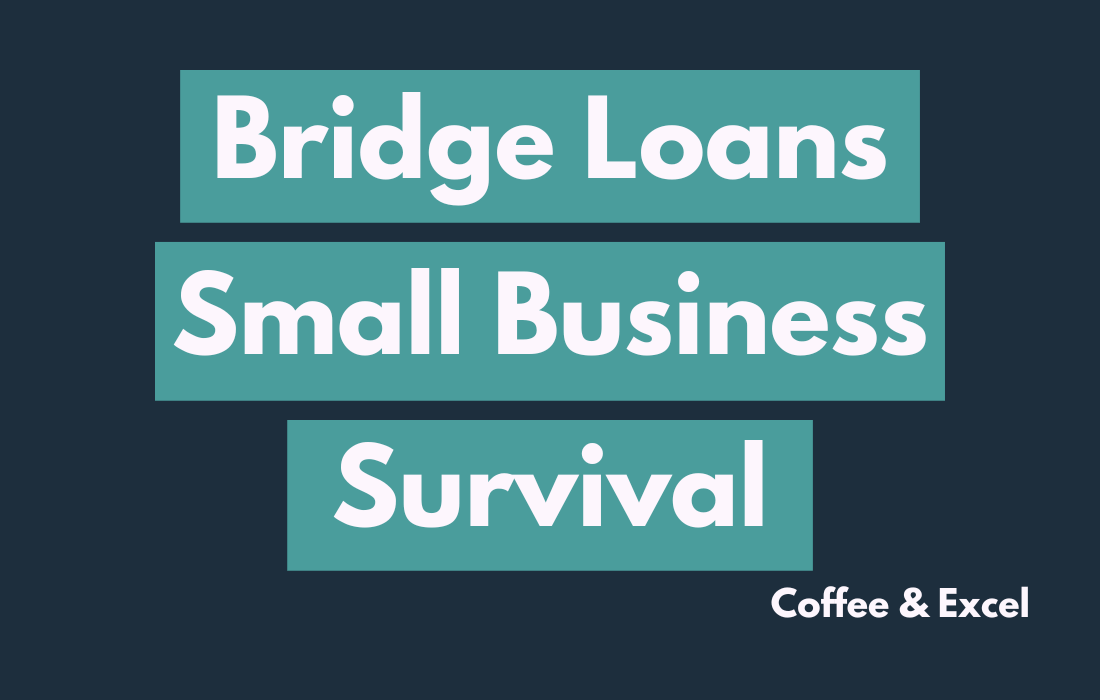Bridge Loans: Your Essential Guide to Small Business Survival

Understanding Bridge Loans
Bridge loans serve as a pivotal financial tool for individuals and businesses alike, particularly in the realm of real estate. These loans are designed to bridge the financial gap between transactions, especially in times when immediate funding is required.
Definition and Purpose
A bridge loan is a short-term loan that provides immediate cash flow and is often used to “bridge” the financial void that occurs when undertaking two separate, but related, transactions. For instance, these loans can offer temporary financing to bridge the gap between the sale of a current property and the purchase of a new one, a common scenario in the real estate market. According to Forbes, bridge loans are typically utilized by homebuyers who need to secure rapid financing to close on a new home while still in the process of selling their current one.
The primary function of a bridge loan is to provide temporary funding that enables smoother transaction timing. The intent is not for these loans to be long-term solutions but rather quick fixes to cover immediate costs, such as down payments or other urgent expenses related to property transactions (Schorr Law).
Common Uses in Real Estate
In the real estate sector, bridge loans are commonly employed in several scenarios:
- Purchasing New Property: They allow buyers to act swiftly in competitive housing markets to secure a new home before they have sold their existing property. This can be particularly useful where buyers encounter their dream home and need to make an immediate offer (Forbes).
- Closing Costs: Bridge loans can cover the costs associated with the closing of a new home. This can be especially handy for buyers who have not yet accessed the equity from their current home (Chase).
Real Estate Investments: For investors, bridge loans can provide crucial financing, especially when traditional bank financing is unavailable or when a rapid closure is necessary on a transaction (TrustABCapital.com).
While bridge loans offer a flexible financing option, they are not without risks. Borrowers must have a clear understanding of the loan terms, including duration, interest rates, and the necessity for an exit strategy. To explore the various loan types and find the one that fits your needs, visit our comprehensive business loans overview, and for more specific guidance on bridge loans, see our loan agreements article.
Key Features of Bridge Loans
Bridge loans are an important financing tool, especially for small business owners looking to quickly bridge gaps in funding. Understanding the key features of these loans is essential for determining if they are the right fit for your financial needs.
Loan Duration
Bridge loans are designed as short-term solutions with a typical repayment period ranging from 6 to 12 months. Some lenders may offer terms that are slightly longer or shorter, depending on the borrower’s needs and the specifics of the situation. According to Forbes and Rocket Mortgage, the average duration of a bridge loan is between 6 months and 1 year, though they are meant to be repaid within about 1 to 3 years.
Interest Rates and Costs
The cost of borrowing via a bridge loan is generally higher than that of traditional long-term financing options due to their short-term nature and the speed and flexibility they provide. Interest rates for bridge loans have been noted to range from 6% to 10%, as reported by Forbes. However, current rates have seen an increase, with Vaster indicating that rates are now between 9.5% and 12%, influenced by changes in the LIBOR rates and Federal Reserve’s interest rate adjustments to address inflation.
Collateral Requirements
Collateral is a key requirement for securing a bridge loan. Lenders generally require the borrower to offer their current property or the property being acquired as collateral for the loan. The loan-to-value ratio for bridge loans is typically around 70 percent, which means that borrowers need to have at least 30 percent equity in the property being used as collateral.
For more information on various loan types and their requirements, you can explore secured vs unsecured loans, which highlights the differences in collateral requirements between loan categories. Additionally, for those seeking further clarity on loan terms, loan calculators can be a valuable tool for estimating monthly payments and costs associated with different loan durations and interest rates.
Understanding these key features of bridge loans is crucial for small business owners when considering this form of financing. It is important to review loan agreements carefully and consider the loan’s duration, costs, and collateral requirements before proceeding. For a broader understanding of business financing options, one can refer to our comprehensive business loans overview and the sba loans guide for federally backed loan options.
Bridge Loans vs. Traditional Financing
When small business owners consider various financing options, understanding the distinction between bridge loans and traditional financing methods is crucial. This section compares these loan types and discusses appropriate situations for each.
Comparing Loan Types
Bridge loans and traditional loans serve different purposes and have distinct terms and conditions. The following table outlines some key differences:
| Feature | Bridge Loans | Traditional Financing |
|---|---|---|
| Interest Rates | Typically 9.5% to 12% (Vaster) | Lower than bridge loans, varies based on loan type |
| Duration | Short term, often up to one year | Short-term, often up to one year |
| Processing Time | Faster approval and funding | Longer due to comprehensive underwriting |
| Collateral | Often required, tied to real estate | Varies, can be secured or unsecured |
| Use Case | Immediate funding needs, transitional financing | Long-term investments, stable growth |
Bridge loans are recognized for their speed and flexibility, which cater to urgent or temporary financial needs. They are typically more expensive than traditional financing, with higher interest rates and fees as noted by Forbes. This cost reflects the higher risk associated with short-term lending and the expedited access to capital.
In contrast, traditional financing options such as SBA loans, commercial real estate loans, or business lines of credit often have lower interest rates and extended repayment terms. These loans are more suitable for long-term business investments due to their stability and more affordable cost structure.
Situations for Each Loan
Choosing between a bridge loan and traditional financing depends on the specific needs and situation of the small business.
Bridge loans are ideal for scenarios requiring immediate cash flow to seize a business opportunity or to address short-term financial gaps. They are often used when awaiting the sale of an asset or the approval of long-term financing. For instance, a business owner might opt for a bridge loan to quickly purchase property in a competitive market, with the intention of securing a traditional mortgage later.
On the other hand, traditional financing is more appropriate for well-planned investments with predictable returns. These might include long-term projects like business expansion, purchasing heavy equipment (small business equipment loans), or franchise financing. Traditional loans are also suitable for business owners with established credit histories who can meet the comprehensive eligibility criteria.
Before making a decision, it’s critical for borrowers to assess their financial situation, project timelines, and repayment capabilities. Utilizing loan calculators can help in understanding the financial implications of each loan option. Additionally, consulting with financial advisors and thoroughly reviewing loan agreements will ensure that the chosen financing method aligns with the business’s objectives and capacity.
Qualifying for a Bridge Loan
Securing a bridge loan can be an integral step for small business owners who need immediate cash flow to bridge a financial gap. Understanding the eligibility criteria and financial considerations are key to determining if a bridge loan is the right option.
Eligibility Criteria
To qualify for a bridge loan, lenders typically examine standard credentials similar to other loan types. These include:
- Debt-to-Income Ratio: Your debt-to-income ratio should ideally be low to demonstrate to lenders that you can manage additional loan payments.
- Home Equity or Collateral: Adequate equity in your property is essential, as bridge loans require collateral—usually your current home or the property you are purchasing (Forbes).
- Credit Score: A strong credit score is often necessary to secure favorable loan terms.
- Household or Business Income: Proof of stable income is crucial to ensure that you can cover the loan payments.
Lenders may also consider the amount of equity you have in your property. With most lenders not exceeding a loan-to-value ratio of 70%, applicants should ideally have at least 30% equity in their property to qualify (TrustABCapital.com).
Financial Considerations
Before applying for a bridge loan, it’s important to understand the financial implications:
- Interest Rates: Bridge loans generally come with higher interest rates, usually between 8.5% and 10.5%, reflective of their short-term nature and higher risk (TrustABCapital.com).
- Loan Duration: These loans are typically short-term, lasting about 6 to 12 months, which necessitates a prompt exit strategy (TrustABCapital.com).
- Repayment Structure: Bridge loans are often designed to be paid off in a lump sum, frequently from the proceeds of a home sale.
- Closing Costs and Fees: As with most loans, there are additional costs involved, such as origination fees and closing costs, which can affect the overall expense of the loan.
When considering a bridge loan, it’s essential to use tools like loan calculators to understand the potential monthly payments and to compare it to other financing options, such as SBA loans, trade credit, or business lines of credit. Additionally, reviewing your loan agreements carefully before committing can help avoid any unexpected financial strains on your business.
For small business owners, bridge loans can offer a swift solution for immediate capital needs. However, it’s critical to ensure that your business’s financial health aligns with the loan’s demands. By thoroughly assessing your eligibility and the loan’s financial impact, you can make an informed decision on whether a bridge loan is the right tool for bridging your business’s financial gaps.
Risks and Considerations
When considering bridge loans as a financial solution for small businesses, it’s critical to be aware of the potential risks and necessary precautions. Bridge loans can offer immediate financial relief, but they come with their own set of challenges that require careful planning and understanding.
Potential Pitfalls
Bridge loans are inherently short-term, high-cost forms of financing that can provide quick capital, but they can also pose significant risks if not managed properly. One of the biggest concerns is the potential risk of the business owner failing to secure long-term financing or the expected income falls through, leading to financial strain or even default.
Another pitfall is the higher cost associated with bridge loans. They are typically more expensive than traditional loans, carrying higher interest rates and additional fees Forbes. The costs can quickly accumulate, making it essential for borrowers to carefully assess their ability to repay the loan within the short timeframe allotted.
Most lenders also assess the risk based on the collateral offered and the borrower’s exit strategy. If the business’s assets or income projections do not suffice, securing a bridge loan may be challenging Schorr Law.
Exit Strategy Importance
Having a well-defined exit strategy is crucial when obtaining a bridge loan. An exit strategy is the borrower’s plan for repaying the loan, typically through the sale of an asset, refinancing with a more permanent financing solution, or the anticipated cash flow from business operations.
Without a solid exit strategy, a bridge loan can become a financial burden. Lenders often scrutinize the feasibility and reliability of the exit strategy before approving a bridge loan. It’s paramount that business owners have a realistic and achievable plan for loan repayment to avoid the risks of extending the loan duration or facing default.
| Consideration | Description |
|---|---|
| Repayment Plan | Must be realistic and achievable to avoid default |
| Higher Costs | Typically higher interest rates and fees than conventional loans |
| Collateral Risk | Potential to lose collateral if unable to repay |
| Short-term Nature | Quick repayment required, often within 6 to 12 months |
| Lender’s Risk Assessment | Based on the viability of the business and exit strategy |
For further insights on different types of financing and how they compare to bridge loans, explore our articles on traditional financing options, such as SBA loans and commercial real estate loans. Additionally, if you are considering other short-term financing options, you may want to read about merchant cash advances and peer-to-peer business lending.
In summary, while bridge loans can serve as a valuable tool for bridging financial gaps, they require thorough consideration of the potential risks and a strong exit strategy to ensure successful repayment and financial stability for your small business.
Managing Bridge Loan Repayments
Navigating the repayment of bridge loans requires a clear understanding of the structures and the impact of external financial events, such as the sale of property. For small businesses and individuals, managing the repayment effectively is critical to financial stability.
Repayment Structures
The repayment of a bridge loan is not typically structured like a standard mortgage or business loan with monthly installments. Instead, these loans are often designed to be paid off in a lump sum. This usually aligns with the sale of the borrower’s current property or the securing of long-term financing. According to Forbes, bridge loans are generally paid off with proceeds from the sale of the borrower’s home.
Given their short-term nature, bridge loans have a duration ranging from six months to one year, after which the full repayment is expected. Chase suggests structuring the loan in a way that allows repayment using money from the sale of a home. It’s advantageous for borrowers to work with their lenders to understand the specific terms, conditions, and any fees associated with their bridge loan Rocket Mortgage.
Borrowers should also use resources like loan calculators to plan their financial strategy and assess how much they can afford to repay once the loan reaches maturity.
Impact of Home Sale Proceeds
The proceeds from the sale of a home are often the primary source for repaying a bridge loan. Since these loans are taken with the expectation that they will be short-term, the timing of the home sale is crucial. If the home sells as anticipated, the proceeds can directly cover the repayment of the bridge loan. However, if there are delays or the sale price is lower than expected, it might complicate the borrower’s ability to repay the loan.
For borrowers, it’s essential to have a solid exit strategy before obtaining a bridge loan. This includes being realistic about the time it may take to sell a home and the potential market fluctuations. Vaster emphasizes the importance of a strong financial profile and the ability to make consistent interest payments.
To ensure financial readiness for the repayment phase, borrowers can explore additional financing options such as franchise financing, trade credit, or even looking into small business microloans as a safety net.
Managing bridge loan repayments is a delicate balance of strategic planning, timely property sales, and understanding the intricacies of loan agreements. By preparing adequately and leveraging the right financial tools and resources, borrowers can bridge their financial gaps successfully.





